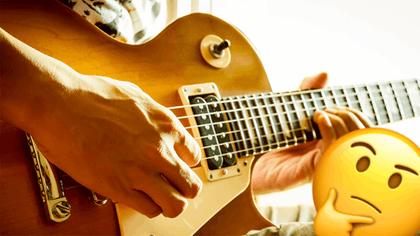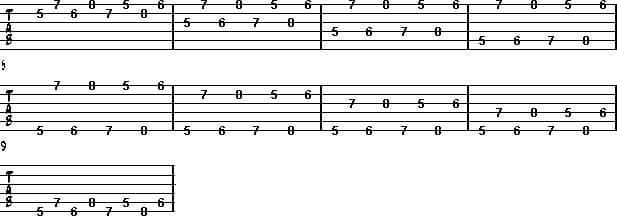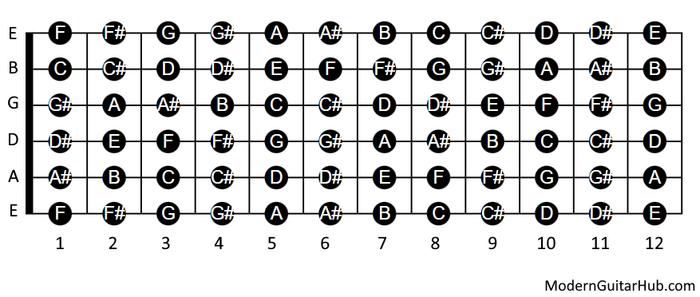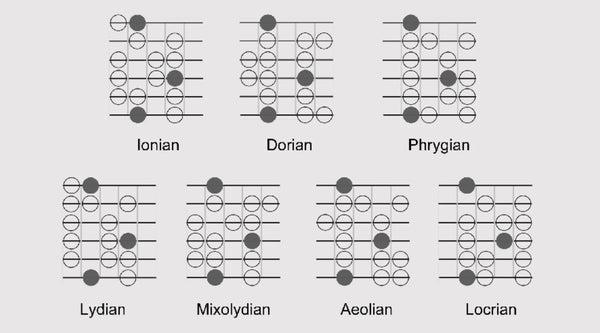Did you ever ponder how some guitarists manage to invent intricate melodies on the spot, while it takes you weeks to learn a single song? This seemingly magical ability is known as ‘noodling on the guitar’, an art form in simplicity, a key to the path of improvisational guitar playing, and you, too, can learn it.
As a lifelong musician and guitar expert, I have spent decades exploring the rich world of improvisational playing. The experience is equivalent to artfully navigating through an ocean of sound, guided by instinct and skill that transforms the guitar into a sprawling canvas for melodies. This approach to guitar playing, referred to as ‘noodling’, has been my creative compass, skyrocketing my engagement with music to unforeseen heights.
Embarking on this journey might feel daunting initially. You might question your ability to create melodies spontaneously, and I assure you, it is a valid concern. However, the exciting and profound truth is that noodling is accessible to anyone, regardless of their level of expertise. It merely requires a sense of courage, the willingness to experiment, and most importantly, strategic guidance to master the art of improvisational guitar playing.
And that’s exactly what this guide offers: the know-how, tips, and techniques you need to unlock your potential and reveal the noodler within. So stretch those fingers and tune up, because we’re about to dive deep into the fascinating universe of guitar noodling.
Understanding Guitar Noodling
What is Noodling

In the domain of guitar playing, noodling is a term used to describe a certain type of improvisation – it often refers to the casual, freeform exploration and practice of licks, chords, and melodies without a specific directive. The joy of noodling on the guitar lies in its essence of spontaneity, discovery and freestyle playing.
If you think you’ve never noodled before, you may want to think again. It’s what you’re doing when you’re mindlessly strumming away while your attention may be elsewhere – perhaps you’re watching TV or chatting with a friend. It’s that free-flowing style of practice where you’re not consciously thinking about scales or theory – that my friends, is noodling.
During my early guitar playing days, I often found myself noodling without even fully realizing it, filling idle time with aimless strumming that, surprisingly, often resulted in newfound skill or understandings. While it may seem somewhat inefficacious to some, I’ve found noodling to be an incredibly valuable aspect of my overall guitar musicianship progression. Its relevance to guitar learning and mastery should not be understated.
In essence, noodling is a distinctive form of guitar freestyle playing, an essential technique in the arsenal of any aspiring guitar player. Its important contribution to enhancing your understanding, practice, and improvisation of guitar playing is typically undervalued but is an integral part of this guide to mastering noodling on the guitar.
Benefits of Noodling

Delving into the realm of guitar noodling benefits, this technique holds great significance in the journey of becoming an intuitive guitar player. Having practised this myself, I can vouch for its transformative impact on guitar playing.
One of the most noteworthy benefits of noodling is the familiarity it brings with the fretboard. Your fingers become naturally intuitive, adjusting to the varying fret heights and string sizes. It lays a sturdy foundation for you to explore and experiment, minimizing the uncertainty that comes with playing an unfamiliar fret or string.
Moreover, noodling encourages inventive and spontaneous playing. Instead of sticking to the conventional scales and exercises, it allows you to freely produce melodies, purely driven by your intuition and emotions. This not only improves your improvisational skills but also adds a personal touch to your performances.
Noodling is also a highly effective technique for muscle memory development. It reinforces the connection between your brain and fingers, making for efficient and smooth transitions between notes and chords. This, in turn, significantly improves your agility and speed.
To wrap up, noodling is more than just a casual play method. It is a voyage of musical discovery, fostering a deeper understanding and kinship with the guitar. By indulging in this intuitive style, you truly allow your creativity to shine, strengthening your bond with the instrument and enhancing your overall musical prowess.
As we unravel the potential further, let’s explore how to enhance your noodling skills and apply it practically on the fretboard. The world of improvisational playing has a lot to offer, and guitar noodling serves as an enriching gateway to it.
Improving Your Noodling Skills
Improvisational Techniques

Having journeyed through the New England Conservatory of Music and successfully mastered noodling, I can confidently state that one of the most enriching adventures you can embark on to enhance your noodling skills is through improvisational guitar playing. By practicing improvisational techniques, you can tap into your ingenuity and truly shape your melodic journey.
The beauty of noodling lies in its inherent spontaneity, just like improvising on guitar. This technique provides the tools to respond instantaneously to musical paths as they unfold. It allows you to establish a distinctive voice with your guitar while also reinventing and creating new melodies that go beyond conventional noodling patterns.
How, exactly, do we delve into these improvisational techniques? By nurturing a few core areas. Firstly, strengthening your understanding and application of scales is vital. Practicing different scales helps you identify and navigate tonal pathways and equips you to weave melodious lines during your improvisation sessions.
Next, it’s essential to approach your guitar with an experimental mindset. This means breaking away from repetition and exploring unique note combinations, rhythms and dynamics. For example, you could mix major and minor scales, or experiment with sliding into notes, bending strings and injecting silence for dramatic effect.
Flexibility is critical for melodic improvisation on guitar. I learned early in my journey that a successful noodling session is not just about playing the right notes but knowing how to tactfully adjust to changes in the music. In order to do this, training your ear is key, which takes time and practice but is ultimately rewarding.
Lastly, remember the adage: ‘Less is often more.’ You don’t have to bedazzle your audience with complex solos. Sometimes, a simple, well-placed note can create more impact than a lightning-fast riff. Be patient and deliberate; think about the notes you’re playing and why you’re playing them. Contemplate the emotion you want your melody to instill.
In the following section, we will dive further into different practice techniques that will help refine your improvisational skills. Remember that while these techniques are meant to guide you, there are no set rules in the world of noodling. It’s a journey of personal exploration, where novel ideas are always welcomed and cherished. So, grab your guitar, infuse it with your spirit, and set forth on your own personal path of melodic discovery.
Practice Techniques

Now that we’ve explored various aspects of improvisation and honed our knack for guitar noodling, it’s time to put our skills to practice. The right kind of practice can take your noodling from something you do occasionally to a significant part of your guitar improvisation repertoire.
Practice, it’s often said, makes perfect. But what’s frequently overlooked is that not all practice techniques are created equal. It’s here where my experience, both as a dedicated guitar noodler and an astute guitar teacher, comes into play. It’s not just about noodling for hours; it’s about noodling with a purpose.
The first of my suggested guitar practice techniques entails consistency. Regular practice, even if for shorter periods, reinforces motor skills and heightens your familiarity with the guitar. Pair this with specific target practise, like improvising over a single chord or focusing on a certain scale, and you’ll find your noodling abilities escalating quickly.
Next, experiment persistently. One rewarding aspect of noodling and guitar improvisation is the room it provides to play around and discover nuances in your style. Try changing the rhythm, experimenting with different fingerings, or integrating various scales. This freedom of exploration will aid in enhancing your personalised sound.
Lastly, remember to record your practice sessions. This can serve multiple purposes. It can not only help you observe your progress over time but also let you hear your music from an audience perspective, enabling you to spot areas of improvement and strengths you can dwell on.
In conclusion, mastering guitar noodling requires effort and time. But with the right techniques and focused practice, you can attain a profound eloquence in your improvisational playing. Remember, the journey to mastery is often as rewarding as the destination itself. Up next, we’ll look at some insights on how to navigate the fretboard with ease and finesse, another crucial aspect of improving your noodling skills.
Navigating the Fretboard

Building one’s comfort and familiarity with the fretboard is like gradually solving a complex puzzle – a thrilling journey for the adventurous. I remember when I first ventured into the realm of the fretboard. Imagine standing at the edge of an unknown territory, acres of land stretching before your eyes, undulating with hills and valleys of notes and chords, calling out to be explored in all its grandeur. The bleak authenticity slapped me with a stark realization that venturing into the wilderness of the fretboard was a leap of faith, a test of courage, which I willingly embraced.
Ever feel lost when trying to explore the vast landscape of your guitar’s fretboard? Let’s turn that overwhelming maze into an intriguing playground.
You see, exploring the guitar fretboard is not as daunting as it seems – it’s about comprehending the patterns, recognizing the chord shapes, and knowing how they connect. Each fret you press down and each string you strum plays a part in the melody you weave. Build familiarization by slowly moving from one fret to another, one string to another. Listen attentively and seek the relation between the notes.
As you travel further down the fretboard, experiment with chord shapes guitar players commonly use, and manipulate them in ways that contribute to your unique sound. The same shapes can translate into different chord variations when shifted to different frets. Understand this, and the fretboard will start speaking your language.
Building finger strength is a crucial aspect of maneuvering the fretboard terrain. Finger strength exercises for guitar, like chord push-ups, finger lifts, and spider exercise, will bestow your fingers with stamina and agility. As your fingers get nimble, you’ll find yourself capable of playing complex licks and solos – navigating the fretboard like a seabird soaring skillfully over the ocean waves.
Deeply entrenched in my years of experience, I’ve found that one of the most exhilarating aspects of music is that it invites you to explore and challenge your boundaries. An adept guitar player doesn’t merely rely on rote learning; they understand their instrument intimately, harness its expressive potential, and confidently improvise their way around.
However, it’s also important to remember, this familiarity with the fretboard doesn’t sprout overnight. It’s a gradual understanding built over time, a fruit of persistence, patience, and audacious exploration.
The guitar fretboard is indeed a fascinating expanse – a canvas for creative expression that extends itself open to the curious and the brave. Embrace the journey, cherish the exploration, and let your fingers dance their way around. Rise to the occasion, spill out your emotions, let your melodies fill the air, and above all else, trust your instincts. Because the music is in you.
In this mesmerizing dance with music, you’ll find yourself – noodling, improvising, creating enchanting melodies – and all the while, falling deeper in love with the guitar.
Incorporating Styles and Techniques

As a long-time noodler, I have found that the key to keep my guitar playing ever fresh and engaging resides not in the confines of well-trodden paths, but in the uncharted territories of experimental soundscapes. It lies in the crux of simultaneously finding comfort in the familiar, while courageously diving into the unexpected, the unique, even the outright strange. It’s all about embracing the delightful unpredictability that comes with creative guitar playing while keeping the foundations of your knowledge anchored to the tried-and-true techniques and styles.
And indeed, who said noodling on the guitar has to be monotonous? Think beyond the tried-and-true, whether it’s experimenting with different styles or exploring innovative playing techniques, the sky’s the limit! This somewhat romantic, even beatnik approach to exploring music on the fretboard breathes new life into the art of guitar playing.
Remember how thrilling it was when you first discovered how to play a minor pentatonic scale on the guitar? Or when you played your first tune using that simple-but-rich rhythm in your strumming patterns? That feeling of accomplishment and the subsequent urge to repeat those newly-learned skills are the hallmarks of what we, guitarists, fondly call noodling. They breathe fresh excitement into every new instance of random guitar playing and can evolve into a truly beautiful technique with conscious guitar practice.
A particularly exciting pursuit for me has been guitar riff improvisation. Fiddling around with various sequences of notes can result in some truly catchy pieces that can either be melded into existing songs or serve as a groundwork for completely new compositions. The same goes for experimenting with advanced guitar soloing techniques. Crafting your own solos, and allowing them to evolve and mature over time, can lead to some truly unforgettable musical moments.
Constantly exploring guitar sounds and the emotions they can portray is a particularly rewarding aspect of noodling. Tweaking even the simplest guitar picking patterns ever so slightly can result in unexpected but pleasing acoustic shades that you may not have otherwise discovered. Feel free to immerse yourself in these hidden depths of your instrument and let them influence your journey.
Guitar playing styles are also an adventurous realm to explore. You might find your tone shaping up as you cherry-pick elements from blues, jazz, classical, rock, or even country. The more diverse your influences, the more groovy, rich, and delightful your improvisational guitar noodling sessions can become.
So next time you pick up your beloved six-string, remember each pluck, strum, and slide is a chance to unearth a new, hidden sonic delight within your playing. Be brave in your exploration, be patient in your practice, and above all, cherish each unplanned melody your fingers offer. Remember, the beauty of guitar noodling lies exactly within its lovely unpredictability and infinite depth – turn it into a journey, not a destination.
FAQs
What is noodling on the guitar?
How can I master noodling on the guitar?
Is noodling on the guitar a good way to practice?
Conclusion
Ever wondered about the untapped potential in your guitar playing? As we draw this journey to a close, let’s recap the transformative power of noodling and how it can remarkably redefine your musical landscape. By grasping the art of noodling on guitar, you are unlocking the door to endless creativity and improving your overall technique.
Further icing your musical prowess is the influential tool of improvisational guitar playing. It polishes your playing styles, provides a better understanding of the fretboard, and broadens your perspectives on music. Bringing these elements to life requires commitment, practice and a willingness to push your musical boundaries.
As we journey together through the world of guitar noodling, remember that each strum, each note, each melody is a step towards becoming a better guitarist. I am not just sharing a technique; I am sharing a passion, one that has shaped my journey as a musician.
So pick that guitar up, venture into the world of noodling and improvisation, and unlock a new layer of musical prowess. And never lose sight of the fact that your most critical tool in this journey is your passion and love for music. Together, let’s explore this vast ocean of promising potential!